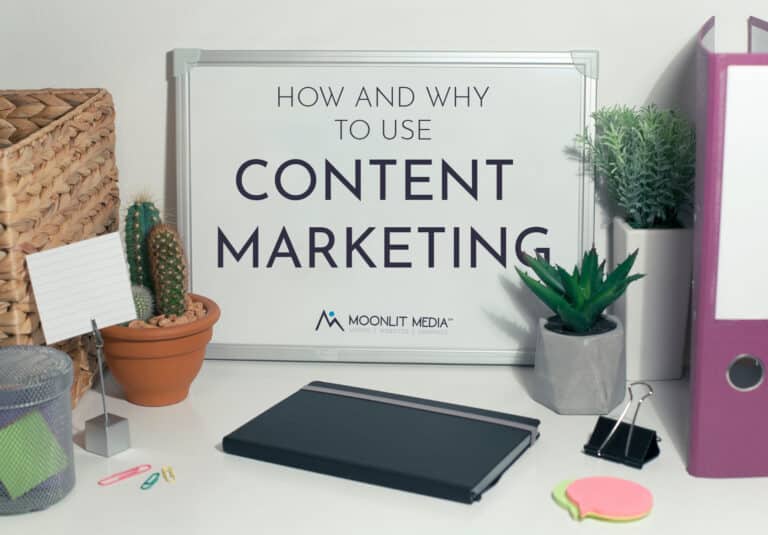Blogging might feel like an old-school marketing tool in a world dominated by TikTok trends and short-form content. The truth is, blogging is still one of the most effective ways to drive traffic and boost your SEO rankings. However, blog content only delivers these results when it’s done strategically.
Many small businesses either blog inconsistently or publish without a clear plan in place. Posting sporadically or choosing topics randomly won’t cut it if you’re trying to stand out online and actually grow your business.
That’s where a solid blog content strategy comes in. We’re here to walk you through every step to create a blog strategy that works for you.

Define Your Blog Goals
Before you start typing, take a step back and ask yourself this simple question: Why am I blogging in the first place? Your reason for blogging should tie directly back to your business goals. Here are a few common objectives to consider:
- Increase website traffic through SEO and audience engagement.
- Build authority in your industry by sharing expert insights and advice.
- Educate existing customers with helpful how-tos or product tips.
- Generate leads or sales with well-placed calls to action.
Once you’ve pinpointed your blogging goals (there may be more than one!), define how you’ll measure success. For example, if your focus is SEO, track organic traffic growth and keyword rankings. If lead generation is the goal, monitor contact form submissions or newsletter signups via your blog. Knowing what success looks like will keep your efforts focused and impactful.

Know Your Audience
Next, get laser-focused on who you’re writing for. Your blog content should speak directly to your ideal audience, addressing their needs, questions, and challenges. Here’s what to consider:
- Who are they? Start with your ideal client profile—is your target audience small business owners, busy moms, or budding entrepreneurs? What do they care about most?
- What problems do they need solved? Identify the key questions they’re asking. Are they looking for beginner-friendly guides? Cost-saving hacks? Insider tips?
- Where are they in their buying journey? Some will just be exploring their options, others will compare different solutions, and a few might be ready to buy. Tailor your content to meet readers wherever they are.
When you truly understand your audience, you’ll write content that feels tailored to them—which builds trust and keeps them coming back for more.

Identify Core Topics and Categories
Your blog needs structure to thrive, and that starts with defining its main themes. No, you don’t have to (and shouldn’t) write about everything. Instead, stick to a few core topics that reflect your business focus.
For example, if you’re a custom home builder, your categories could include:
- Design inspiration
- Building tips
- Financing advice
This approach not only makes your blog more organized for readers but also helps you target specific SEO keywords most effectively. Categorizing your content also signals to search engines what your site is about, making it easier to rank for your chosen topics.
Do Keyword Research
Keyword research is the backbone of any successful blogging strategy. It’s how you align your content with what people are searching for online. Here’s how to get started:
- Use keyword research tools. Platforms like Google Keyword Planner, Ubersuggest, and SEMrush can help you uncover relevant search terms.
- Focus on long-tail keywords. While generic phrases like “blogging strategy” are highly competitive, long-tail keywords (e.g., “create a blog strategy for small businesses”) tend to have less competition and attract more qualified traffic.
- Don’t forget local SEO. If your business serves a specific geographic area, include location-based keywords, such as “best web design agency in Austin.”
By targeting the right keywords, your blog posts can attract readers who are actively searching for answers in your niche.
Plan Your Content Calendar
Consistency is key when it comes to blogging. But here’s the thing—not every business needs to post weekly. The right frequency depends on your capacity and resources. Whether you choose to blog monthly, biweekly, or weekly, commit to a rhythm you can realistically maintain.
Your content calendar should map out:
- Your posting schedule. Choose specific dates to keep yourself accountable.
- A mix of evergreen and trending topics. Evergreen content (like how-tos or guides) stays relevant for the long haul, while seasonal topics create timely engagement.
Using tools like Google Sheets, Notion, or project management platforms like Trello can make organizing your calendar a breeze.

Write with Purpose and Personality
Forget dry, corporate tones or overly salesy language. Your blog should sound like you! Readers connect with blogs that are authentic, helpful, and even a little fun to read.
- Keep posts skimmable. Use headers, subheaders, and bullet points to break up long chunks of text.
- Be the guide, not the salesperson. Offer value first, and use a subtle call to action (CTA) like, “Contact us to learn more,” at the end.
- Infuse your personality. Whether your brand voice is witty, friendly, or professional, let it shine through your writing.
Promote Your Blog Posts
Once your blog is live, don’t just sit back and hope the clicks start rolling in—promote it!
Sharing your posts through different channels can significantly expand your reach. Consider using email newsletters to connect with your existing customers and keep them updated with your latest content. Social media platforms like Instagram, LinkedIn, or Facebook are also excellent for sharing posts, especially if they align with where your audience spends their time.
Additionally, think about repurposing your blog posts into other types of content. You could create Instagram Reels, design Pinterest pins, or develop engaging infographics to draw in a wider audience.
Don’t forget the value of direct engagement, either. Responding to comments, encouraging discussions, or giving shout-outs to users who share your blog are fantastic ways to build a loyal and interactive community around your content.
Track What’s Working (and What’s Not)
Blogging isn’t a set-it-and-forget-it kind of strategy. Analyze your posts regularly to uncover what resonates most with your audience. Key metrics to track include:
- Traffic (how many people are visiting your blog?)
- Bounce rate (are readers sticking around or leaving immediately?)
- Time on page (are they engaging deeply with your content?)
- Conversion rates (are readers taking the action you want, like signing up for a newsletter?)
Use what you learn to fine-tune your content strategy, updating old posts or pivoting your focus if necessary.
Turn Your Blog into a 24/7 Marketing Machine
When done right, your blog can do a lot of heavy lifting for your business. It drives traffic, improves SEO, and converts readers into customers.
A successful blog will start small. But stay consistent and always focus on delivering value and it will eventually pay you back in dividends. Need help getting there? Our copywriters at Moonlit Media can craft blog posts that don’t just attract visitors but actually convert them into clients. Plus, we build beautiful, SEO-friendly websites to host them.
When you’re ready to make blogging a powerful part of your marketing toolkit, contact us for expert help tailored to your growth goals.








